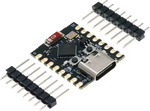ESP32-C3 on sale for $3.92, which is 50% off it's original price of $7.85. Great development board for small projects that require wifi.
Description:
The ESP32-C3 SuperMini is a tiny yet powerful development board designed for makers, hobbyists, and IoT enthusiasts.
Details:
Compact Size: At just 22.5mm x 18mm, this board is truly miniaturized. It won’t take up much space in your projects, making it ideal for wearables, sensor nodes, and compact gadgets.
Wireless Connectivity: The ESP32-C3 SuperMini supports both WiFi (802.11b/g/n) and Bluetooth 5.0. Whether you need to connect to your local network or communicate with other devices, this board has you covered.
RISC-V Architecture: The heart of the board is a 32-bit single-core RISC-V processor running at 160MHz. It’s efficient, capable, and ready to handle your code.
Memory and Flash: With 400KB of SRAM, 384KB of ROM, and 4MB of onboard Flash memory, you’ll have plenty of space for your applications and data.
Versatile I/O: The ESP32-C3 SuperMini offers a wealth of I/O options:
1x I2C
1x SPI
2x UART
11x GPIO (including PWM)
4x ADC
Easy Soldering: The castellated module design allows you to solder the board directly onto your carrier board. No bulky connectors needed!
Blue LED Indicator: There’s an onboard blue LED to give you visual feedback during testing and debugging.
Common Accessories:
Breadboards 400 or 830 tie-point breadboard would be fine
Breadboard Power Supply Can operate at 3.3V & 5V
Jumper wires Great for connecting off-board components & modules to the circuit


Can this be shipped to parcel locker with the cheap shipping?